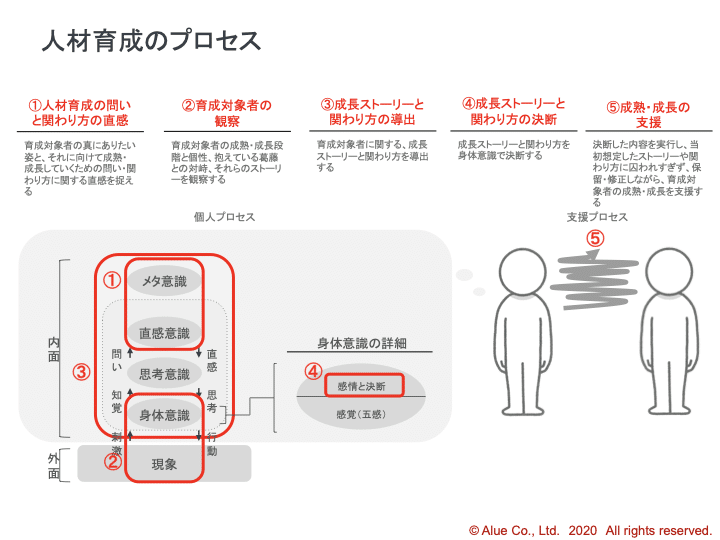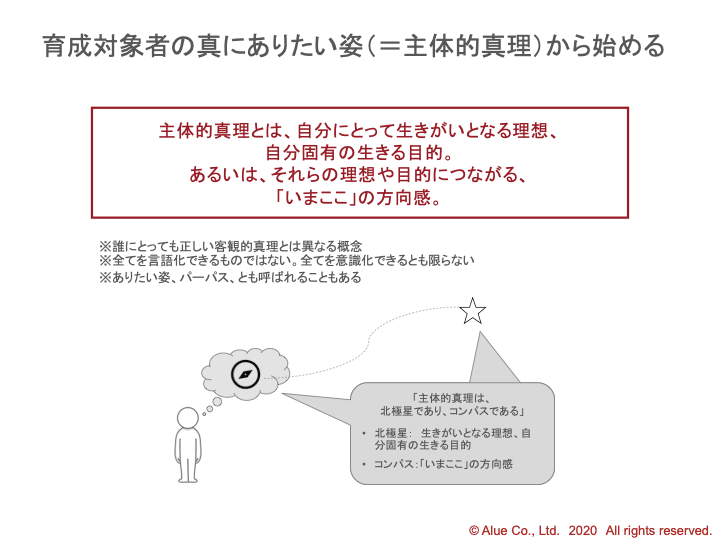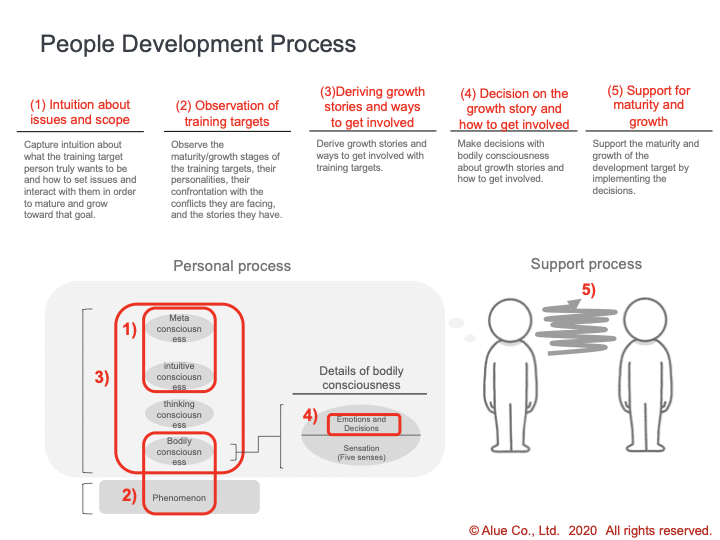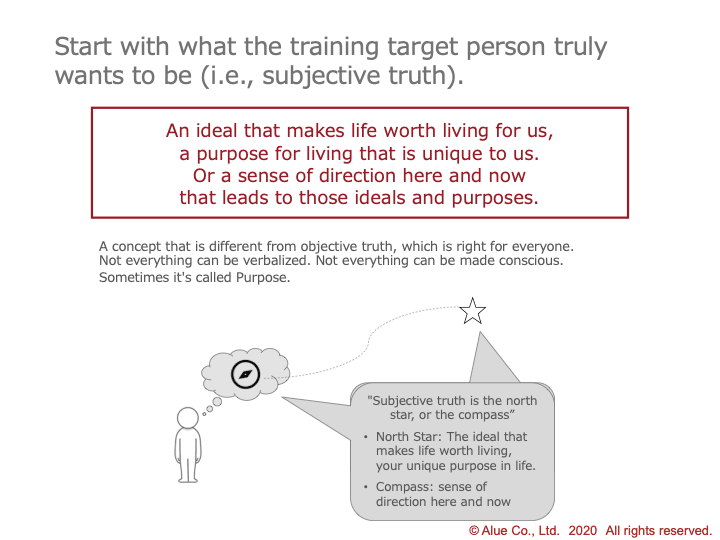
相手の悩みをいきなり解決しようとしてはいけない理由
前回の記事では、人の本質的な成長のためには、適応課題への対応、すなわち価値観レベルの変容に向き合うことが求められることをお伝えしました。
今回は、技術課題への対処だけではなく、価値観レベルの変容が伴うような成長を支援するための具体的なプロセスについてお話しします。
人材育成は何から始まるか?
ここからは、会社において上司が部下を育成する場面を想定し、上司、つまり「育成する側」の視点で話を進めていきます。
読者の中には、育成される側の立場の人もいるかもしれませんが、近い将来、自分が育成する側になるときのことを想像して、読み進めてみてください。
育成する側から見ると、人材育成は以下のようなプロセスで進みます。

細かい中身を理解しようとしなくても構いません。ここでぜひ押さえていただきたいのは、実際の支援にいく前に様々なプロセスがあるということです。
実際の支援は、ここでは「⑤成熟・成長の支援」という最後の部分です。その前のプロセスはすべて、育成する側で完結する話です。育成対象者と実際にコミュニケーションを取る前に、様々な準備が求められます。
準備といっても、決して一人で考え込むことを求めるわけではありません。人材育成は、育成対象者を観察することから始まります。準備の中でもっとも重要となる「②育成対象者の観察」についてお話ししましょう。
始まりはいつも「主体的真理」から
具体的な支援の前に、育成対象者をとにかく観察することが重要です。
・育成対象者の「願い」は何か?
・「願い」に対して、今どのような葛藤を抱えているか?
・今後、どのように葛藤を乗り越えていけそうか?
こういったことにインスピレーションを得るために、観察を行ないます。
実は、この願いと葛藤を捉えていくという構図は、自分自身の精神的成熟と全く同じです。違いがあるとすれば、人材育成は、対象が自分ではなく相手であり、そのために自分はどう関われるか?という視点で考えるということです。精神的成熟そのものについては、次の記事も参考にしてください。
育成対象者の「願い」という言い方をしました。これはまさに、私がキーワードにしている「主体的真理」のことです。
主体的真理とは、「自分にとって生きがいとなる理想、自分固有の生きる目的」のことです。「自分にとっての」という部分が重要であり、客観的真理とは明確に区別されます。

主体的真理を自覚することは、実はとても難しいことです。様々な経験と実践を踏まえ、自分の中での内省と周囲の人との対話を繰り返す中で、ようやくおぼろげに見えてくるものだと思ったほうがいいでしょう。
人材育成においても、育成対象者が主体的真理を自覚していることは稀です。ですから、まずはその人の主体的真理がどこにありそうかを、おぼろげながら感じ取ることからスタートします。
主体的真理というキーワードをご紹介致しましたが、少し聞き慣れない表現かと思いますので、これからの記事では主に「願い」という言葉を使うことにします。その「願い」というのは、本質的には主体的真理のことであるとご理解いただければと多います。
相手の願いを捉えようとすることから始まる。そのことを理解したとしても、どのように相手の願いを理解すればいいのかわからないという方もいらっしゃるかもしれません。部下にどのような願いをもっているかを直接的に聴くことももちろん良いと思いますが、先にも述べた通り、本人が自分の願いを自覚しているとは限りません。
相手の願いを感じ取るときに、実はポイントになるのが相手の「悩み」です。
「悩み」は「願い」の裏返し
人によって「悩み」は千差万別です。同じ状況下でも、悩む人・悩まない人がいますし、「悩み」の内容も異なります。

悩むポイントが人によって違うのは、その裏にある「願い」が異なるからです。いつも同じようなことで悩む、あるいは、深く悩んでしまう。そういったことほど、本質的な「願い」に近いのかもしれません。
例えば、部下が、お客様からの信頼を得ることができていないことに悩んでいたとします。そこに悩んでいるということは、部下はお客様からの信頼を得たいと願っているとも言えます。さらに言えば、自分が関わる周囲の人から信頼されたいという願いを持っているのかもしれません。
「悩みがない人はいない」とも言えるほど、悩みは日常的です。このように書いている私にも常に悩みがありますし、これを読んでいただいてる皆さんにも悩みがあるのではないでしょうか。
あなたの部下の方にも、何らかの悩みがあると思います。まずは、その悩みを理解することから始めるのはいかがでしょうか。
しかし、まだ出会ってから間もない場合は、いきなり「悩みは何ですか?」と聞いても部下の方は答えてくれないかもしれません。

そのようなときは焦らずに、まずは信頼関係を構築することに重きを置いて、コミュニケーションを重ねていくのが良いと思います。そのうち、自然と悩みを打ち明けてくれたり、直接伝えられていなくても、悩みを感じ取ることができるようになります。そして、その悩みの背景にある、願いについても感じ取ることができるようになるでしょう。
「悩みに寄り添う」ということについて突き詰めて考えて、ビジネスとして実践されている方がいらっしゃいます。私も一緒に仕事をさせていただいたことがあるトーチリレーの神保拓也さんです。「悩みに寄り添う」ということがどういうことか、是非ともこちらの書籍あるいはnote記事をお読み頂くことをお勧めいたします。
「悩み」を解決しようとしてはいけない
あえて、悩みに「寄り添う」という言い方をしました。
一般的に、悩みを聴くと解決してあげたくなります。しかし、本人ではない他者がいきなり本人の悩みを解決しようとすることは、人材育成の観点ではプラスにならないことが多いです。
一見、解決できたように見えたり、アドバイスしてくれたこと自体が嬉しくなって、解消したような気がしたりすることはあっても、他者がいきなり介入して解消できることは限られています。
仮に他者からの介入によって解消できたとしても、人材育成の観点で言えばプラスとは限りません。「自分の悩みに対して、自分で(自分が主体となって)乗り越えていくこと」を支援することが本筋ではないでしょうか。「魚を与えるのではなく、魚の釣り方を教える」ことが育成の本筋ではないかと思います。
もちろん、介入すること自体がよくないと言っているのではありません。悩みが技術課題に近いのであれば、知識を教えたり、スキルの習得を支援したりすることは有効でしょう。
ですが、適応課題への対応を伴うような悩みは、もやもやとしていて、本人すら何に悩んでいるのかはっきりと自覚できていません。そして、そのように深く悩んでいることについて、周囲の人は理解することはできないと思っている場合もありますし、周囲の人が聴く耳をもっていない場合もあります。
そのような悩みは、いきなり解決しにいってはダメです。まずはただ聴く、あるいは観察して、相手の悩みに寄り添うことが大切です。そして、寄り添っている中で、本人の願いを少しずつ理解していくようなイメージになります。

悩みをいきなり解決しようとしてしまうと、相手とは別の客観的な立場からモノを言うことになります。自分と相手を分離した状態では、相手の悩みを解決することはできませんし、相手の本質的な願いや主体的真理にたどり着くことはできません。
相手がこれまで経験してきたこと、場合によっては長い人生経験全体を共有した上で、今の「悩み」を同じ立場でただ感じるのです。
相手の靴を履く
私はこれを「相手の靴を履く」と表現しています。
ただし、相手のすべてを引き受ける必要はありません。というか、そんなことはできません。
相手の悩みは相手のものです。主人公を取って代わることはできません。第三者にできるのは、成長のための「同行者」になることです。相手の靴を履いてみた上で、隣に立って、同じ方向を見ているイメージです。あるいは、もう少し大袈裟に表現をすれば、相手に憑依する感じです。
相手の靴を履くというアプローチは、悩みに対してコンサルティングのようなアプローチではなく、相手が感じていることを自分ごとのように感じ取れるレベルで相手のことを理解しようとする文化人類学的なアプローチに近くなります。
このように考えると、本当に深いレベルで相手に寄り添おうとすれば、長い時間がかかることがご理解いただけると思います。
まずは相手の人生のストーリーを共有してもらわなければいけませんし、その前提として、そういったことを包み隠さず話せる信頼関係をつくる必要があります。それは、日々のコミュニケーションの積み重ねによって培うものであり、一朝一夕にはできないことなのです。

今回の記事では、人材育成の始まりは相手の願いであるということ、そして願いをいきなり聞き出そうとするのではなくまずは相手の悩みに寄り添おうとすることの大切さについてお話しいたしました。次回は、相手に寄り添うときに前提となるコミュニケーションと関係構築についてお話しします。
本日の問いとなります。(よろしければ、コメントにご意見ください)
・いま、あなたが感じている「悩み」は何ですか?その背景には、どのような「願い」がありますか?
・上記の問いを考えているときに「悩み」と「願い」のどちらが思い浮かびやすかったでしょうか?そして、それはなぜだと思いますか?
The reasons why we should not try to solve problems of others immediately
In the previous article, I told that in order for people to grow essentially, they need to deal with adaptive challenges, i.e., to face the transformation of the value level.
In this article, we will discuss a specific process for supporting growth that not only addresses technical challenges, but also involves a transformation of the value level.
Where does people development begin?
From here, we will assume a situation in which a supervisor trains his/her subordinates in a company, and proceed from the perspective of the supervisor, in other words, the "trainer".
Some of you may be on the side of those being trained, but please try to imagine yourself on the side of those training subordinates in the near future.
From the perspective of those who train them, people development proceeds through the following process.

You do not have to try to understand the details. What I would like you to keep in mind is that there are various processes before going to the actual support.
The actual support is the last part here, which is called "5) Support for maturity and growth. All the processes before that are all to be completed by the person who provides support. Various preparations are required before actually communicating with the training target.
Preparation does not mean that we ask you to think alone. People development begins with observation of the training target. Let's talk about the most important part of the preparation: (2) Observation of training targets.
It always starts with "subjective truth"
Before providing specific support, it is important to observe the training target person anyway.
・What are the "wishes" of the target person?
・What kind of conflicts do they have about their wishes?
・How will they be able to overcome the conflicts in the future?
We make observations to gain inspiration in these matters.
In fact, the composition of capturing wishes and conflicts is exactly the same as one's own mental maturity. The difference is that in people development, the target is the other person, not us, and we think from the perspective of how we can be involved in the process.
For more information on mental maturity itself, please refer to the following article.
I used the term "wish" for the training target. This is exactly what I mean by the key phrase " subjective truth".
Subjective truth is " an ideal that makes life worth living for us, a purpose for living that is unique to us. The "for us(me)" part is important and clearly distinguishes it from objective truth.

Becoming aware of the subjective truth is actually very difficult. It is best to think of it as something that finally becomes dimly visible through repeated reflection within oneself and dialogue with those around one, based on various experiences and practices.
In people development as well, it is rare that training targets are aware of their own subjective truths. Therefore, the first step is to get a dim sense of where the target person's subjective truth may lie.
I have introduced the key word "subjective truth," but since it may be a little unfamiliar to you, I will mainly use the word "wish" in the following articles. I hope you will understand that this "wish" is essentially a subjective truth.
It starts with trying to capture the person's wishes. Even if you understand this, you may not know how to understand their wishes. It is of course good to ask your subordinate directly what kind of wishes he or she has, but as mentioned earlier, he or she may not always be aware of his or her own wishes.
When sensing the other person's wishes, the key point is actually the other person's "worries".
"Worries" are the flip side of wishes
People's "worries" vary from person to person. Even in the same situation, some people are troubled and others are not, and the contents of their " worries" are also different.
The reason why the point of worries differ from person to person is because the "wishes" behind them are different. Sometimes we tend to be troubled by similar matters repeatedly. Such matters might be close to the essential wish.
For example, suppose a subordinate is troubled by the fact that he or she has not been able to gain the trust of customers. The fact that he/she is worried about this can be said that he/she wishes to gain the trust of customers. Furthermore, he/she may be wishing to be trusted by those around him/her with whom he/she interacts.
Worries are so commonplace that one could say, "No one is without worries." Even as I write this, I am constantly worried, and I am sure that everyone who is reading this has worries as well.
I am sure that your subordinates have some concerns as well. Why not start by understanding their problems?
However, if you and your subordinate have only just met, you may not be able to get a good answer from your subordinate by suddenly asking, "What are your concerns?"
At such times, it is best not to rush, but to focus first on building a relationship of trust and continue to communicate with them. Eventually, they will naturally confide their concerns to you, and you will be able to sense their worries even if they are not directly communicated to you. And you will also be able to sense the wishes behind those worries.
There are some people who have thought long and hard about the concept of "being close to people's worries," and are practicing it as a business. I have had the pleasure of working with Takuya Jimbo of Torch Relay. To learn more about what it means to be "close to people' s worries," I highly recommend you to read this book or his notebook article.
Do not try to solve "worries" of others
I dare to say that " to be close" to worries.
Generally, when we listen to a person's worries, we want to help him or her solve his or her problems. However, it is often not positive from the perspective of people development when others who are not the person in question suddenly try to solve the person's problems.
At first glance, it may appear that the problem has been resolved, or the person may feel happy that the advice was given and feel that the problem has been resolved, but there are only a limited number of things that can be resolved by the sudden intervention of others.
Even if the problem can be resolved by intervention from others, it is not necessarily a positive thing from the perspective of people development. The main idea of people development is to help people overcome their problems on their own (on their own initiative). The main idea of nurturing is not to give them fish, but to teach them how to fish.
Of course, I am not saying that intervention itself is not good. If the problem is similar to a technical challenge, it may be effective to teach knowledge and support the acquisition of skills.
However, worries that involve dealing with adaptive challenges are hazy, and even the individual is not clearly aware of what is troubling him or her. In some cases, they may feel that the people around them cannot understand nor are they willing to listen to their deepest concerns.
We should not go out of the blue to solve such problems. First of all, it is important to simply listen or observe and be attentive to their concerns. As we listen and observe, we will gradually come to understand the person's wishes.
If we try to solve their problems out of the blue, we will be speaking from an objective standpoint that is different from theirs. If we separate ourselves from training targets, we will not be able to solve their problems, and we will not be able to reach their essential wish or subjective truth.
we should simply feel the current "concerns/worries" from the same standpoint, after understanding what they have experienced so far, and in some cases, the entire long life experience.
Put ourselves in the subordinates' shoes
I describe this as " putting ourselves in the subordinates' shoes".
However, we do not have to take on all of our subordinates. Or rather, we cannot do that.
Their problems are their own. We cannot replace the protagonist. What a third party can do is to be a "companion" for growth. This is the image of putting ourselves in the subordinates' shoes and then standing next to them, looking in the same direction.
The approach of putting ourselves in our subordinates' shoes is not a consulting approach to their problems, but is closer to a cultural anthropological approach that tries to understand our subordinates at a level where we can feel what they are feeling as if it were our own.
In this way, we can understand that it will take a long time if we really want to be close to our subordinate at a deep level.
First of all, we have to get our subordinates to share their life stories with us, and as a prerequisite for this, we need to create a trusting relationship in which we can talk about such things without concealment. This is something that is cultivated through daily communication and cannot be done overnight.
In this article, we discussed the fact that people development begins with the wishes of subordinates, and the importance of first trying to be attentive to their concerns, rather than suddenly trying to find out their wishes. In the next article, we will discuss communication and relationship building, which are the prerequisites for being close to subordinates.
Here are the quests of the day. (If you'd like, please share your thoughts in the comments.)
・What are the " worries" you are feeling right now? What kind of "wish" is behind it?
・When you were thinking about the above questions, which came to mind more easily, your "worries" or your "wishes"? And why do you think that is?
Bunshiro Ochiai
この記事が気に入ったらサポートをしてみませんか?
